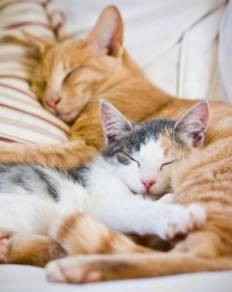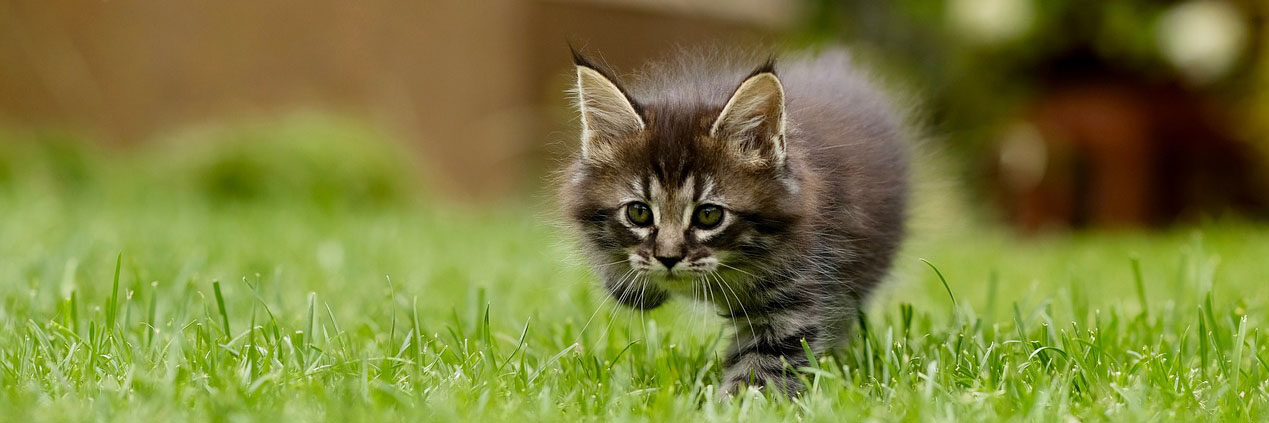Welcoming your new kitten

Set up “basecamp”
When you take your kitten to her new forever home, she will be overwhelmed and a little frightened. The best way to reduce the stress and fear for her is to create a separate area of your home (either a room you can close the door on, or a quiet corner where everyone can be kept away), and provide everything she needs in this enclosed space; a bed, litter tray, food and water, and some toys. She will take her time to explore her new territory, so leave her to do this for a while; either leave the area or sit down very still and speak quietly to her. Do not approach her, let her come to you. In a short time, your new kitten will get to know her new home, and you can gradually expand her area by moving her items into the rest of the house, giving her the message that this is also her territory. Take this slowly, and ensure she is comfortable. Always leave something in “basecamp” for her to return to, where she will feel safest.
Introducing your family (including children)
If you have a large family, or children, new people should be introduced to the kitten one at a time, if possible. This will make it less likely she will be overwhelmed. Children can of course be excitable, particularly in the presence of a new kitten, so encourage them to be calm and quiet, and gently allow the kitten to come to them to be petted. Loud and sudden noises will most likely frighten the kitten, whereas a quiet first encounter, perhaps involving a little playtime with kitten and child will ensure a happy future relationship for both.


Introducing other cats
If you have other cats in the house already, how they react to the new kitten will largely depend on their individual personalities, age, previous experience and general temperament.
If you have set up a basecamp for the kitten as above, the easiest way to begin the introductions would be the “scent-swap” – after a few days, and once the kitten has settled, take something from their area and give it to your cat(s) to smell. You can also take something from the rest of the house which smells like your cat(s), for example a blanket, and place it in the kitten’s area, for her to smell. You can swap items around for a few days until all parties are familiar with each others’ scent. This is the primary method by which cats navigate the world, so allowing them to be introduced in this manner will prepare them very well for the second stage; face to face meeting.
The best time to introduce cats to one another is at mealtime. Everyone is hungry, and food is always going to be more enticing than fighting, so in most instances the result is that the separate parties mostly ignore one another. Another advantage of using mealtime for the introduction is that this will be one of all the cats’ favourite times, so you are making a positive association with the newcomer in the mind of your existing cat(s).
You can also introduce play; all cats playing the same space, but with different people and toys is another good way to make the positive associations. All being well, you can then graduate to having the cat(s) and kitten playing all together with the same toy.
If you find at any stage that there is serious aggression on either side, step back and keep the cats separate for a few more days. Then try again, building up the contact slowly (always ensuring all parties have an exit route from the situation if things deteriorate).
A little hissing is to be expected; this will be your existing cats pulling rank, and letting the newcomer know this is their territory, and they are in charge. Unless this becomes physical aggression, this is nothing to worry about, and will almost certainly calm down by itself in a day or two.
It is important to manage your expectations in terms of feline relations – your new kitten and existing cat(s) may become the best of friends, but they may merely tolerate one another (or anything in between). As long as they get along peacefully, all is well.
Introducing dog(s)
Introductions to dogs are largely similar to the steps above for introducing cats, and again, the success and timing will largely depend upon the temperament of your dog(s). You should make all introductions with your dog wearing his lead, and you holding it firmly, to prevent any sudden attacks, should they occur. A dog (even a small one) could seriously injure or even kill a kitten, so even if you think your dog is the most placid around, if they have no experience with cats, or are known to chase them, please ensure they are kept under control until relationships between dog and kitten are on friendly terms.
Making the introductions gently, then following it with feeding time will help to build positive associations in the minds of both dog(s) and kitten.
Never leave your dog(s) unattended with the kitten until you are certain it is 100% safe to do so.

Dos and Don’ts
Do leave your kitten to explore her new territory on her own at first, give her space.
Do spend as much time as possible with your new kitten once she has begun to settle, in order to build a bond.
Do ensure you provide fresh water at all times, and provide a suitable food (up to 12 months of age, kitten-specific food is highly recommended)
Do ensure you get your kitten’s second vaccination when it is due, and continue to get her vaccinated annually to protect her against illness and disease.
Do get your kitten neutered or spayed at around four months of age. This is not only important to prevent unwanted kittens; neutering and spaying will eliminate undesirable behaviours in your growing kitten (for example, yowling in females, spraying and roaming in males). Additionally, cats which have been neutered or spayed have been shown to be protected from a range of illnesses and diseases in later life, including certain cancers.
Don’t let your kitten go outside until they have been fully vaccinated and neutered/spayed.
Don’t give your kitten milk to drink. Despite the cliché, most cats become lactose intolerant as they grow into adulthood, and this will most likely upset their stomach. Stick to water, ensuring it is always fresh.
Don’t give your kitten human food – there are many foods which are highly toxic to cats (for example onions, garlic, chocolate, caffeine…) Kitten food contains all the nutrients your kitten needs, and aside from the occasional cat treat, this should not be supplemented.

